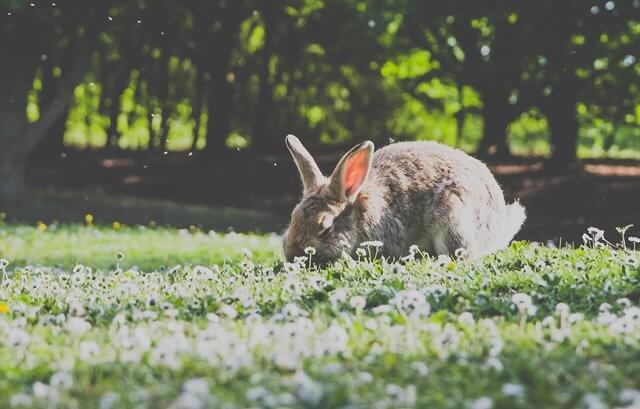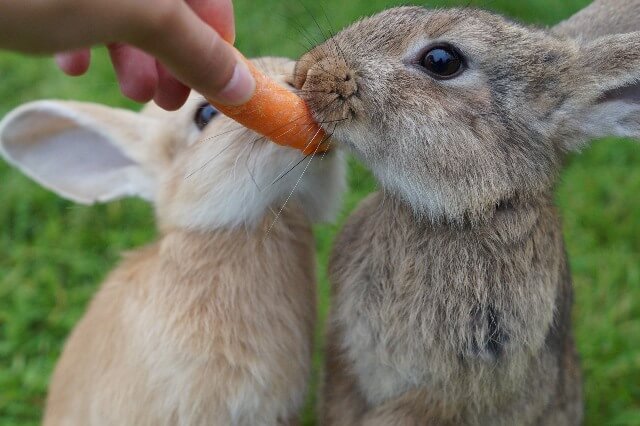An Introduction to Rabbits

Rabbits are often very popular ‘first pets’ bought for children as they are seen as being ‘easy’ to house and care for. In reality, rabbits have very specific social, environmental and dietary requirements that need to be provided in order for them to live happy, healthy lives. In this article, we will look at why rabbits have developed certain traits and behaviours (originating from their wild cousins) and how this may impact you and your pet rabbit.
Diet
One of the most unique differences, when you compare rabbits to other pets such as dogs and cats, is that rabbits are herbivores - this means that they get all of their energy and nutrients from eating plants. However, plants contain lots of tough fibrous material (cellulose) that can be very difficult to digest so the rabbit has some very unique adaptations to help them get the most out of their diet:
Teeth
A rabbit’s teeth are very different to those found in animals that eat meat as part of their diet (such as dogs, cats and even humans). A rabbit doesn’t need sharp and pointy teeth to ‘rip’ meat apart, instead, a rabbit has flat teeth that grind against each other and mash up the tough plant material. This grinding motion wears the teeth away over time and so a rabbit’s teeth are continually growing; this means that if a rabbit does not eat enough fibrous plant material each day then their teeth can overgrow and cause severe dental problems and mouth sores.
Gut Bacteria
Rabbits (and most other herbivores) are not able to digest plants on their own – they must have help from special types of bacteria (and other microscopic organisms) that live in their gut and digest the cellulose for them, releasing the nutrients and energy that the animal needs. This process of bacteria digesting plant material for the animal is called ‘fermentation’ and it’s a process that requires time and space. In rabbits, most of the bacterial fermentation of food takes place in their large intestine, in a special chamber known as the caecum, which is 10x larger than their stomach!
Eating Poop!
Another way that rabbits maximise the energy and nutrients they can get from plants is by digesting their food twice and that’s why Rabbits make 2 different types of poop:
- In the caecum, once the fermentation process starts, the rabbit makes ‘poop parcels’ called caecotrophs. These caecotrophs contain bacteria, partially digested plant material and have a mucus coating – the rabbit will then eat the caecotroph directly from the anus (so it is unusual to see them) from where they pass back into the stomach and through the intestines again; enabling the rabbit to absorb even more energy, nutrients and vitamins. Rabbits usually only produce caecotrophs once a day, either early in the morning or late at night, and it is an extremely important process – rabbits that do not eat their caecotrophs can become deficient in essential vitamins and minerals which can make them very ill. If a rabbit is fed a diet that is very high in sugars/carbohydrates and low in fibre (such as ‘rabbit muesli’) then it may stop eating its caecotrophs and develop nutritional deficiencies.
- The small hard round ‘balls’ of poop, that most people who keep rabbits will be familiar with, are full of large fibre particles that cannot be digested; this type of fibre is essential to keep the rabbit’s guts moving properly but has little nutritious value so will not be re-eaten by the rabbit. If a rabbit does not eat enough of this type of ‘indigestible’ fibre (by not eating enough hay/grass or other suitable fibre sources) then it can develop severe gut motility issues and become very ill.

Habitat/Environment
In the wild rabbits are ‘prey’ animals (they are hunted by other animals for food). This is important as rabbits have developed specific behaviours to help protect them;
- They live underground in burrows and generally they only come above ground in the early morning and at night (times of day with ‘low light’ help protect them from being seen by predators). This means your pet rabbit may be very active at dawn and dusk and may want to sleep/hide more during the day. Every rabbit house/hutch should have a covered area where your rabbit can go to ‘hide’ if it is feeling stressed or scared. As rabbits are excellent at digging, outdoor enclosures should be secure enough to stop them from making escape tunnels!
- They live in very large colonies with lots of other rabbits - So pet rabbits will likely be significantly happier (and more confident) being housed with a companion; although take care as putting unknown rabbits together as adults can result in aggression and fighting (rabbits are very territorial!). Speak to your vet for advice if you are considering introducing a new rabbit to your existing pet rabbit.
- Rabbits are prolific breeders - this means they are capable of producing large numbers of baby rabbits, called ‘Kits’, in a short space of time (which helps keep the population numbers high in the wild). Female rabbits can start producing babies as young as 5 months of age and can have as many as 14 babies every 1 to 2 months so one breeding pair of rabbits could, hypothetically, produce more than 160 kits a year! If you are going to keep 2 or more rabbits together then it is important to ensure they are the same sex or speak to your vet about neutering (otherwise you may end up with a lot more pet rabbits than you intended!)
- In the wild rabbits use their strong back legs and long front teeth for defence against predators which means that, if scared, your pet rabbit can deliver a painful bite and a powerful kick; this can cause quite a bit of damage (especially to children). Pet rabbits are more likely to be aggressive if they have had little or no socialisation/handling as youngsters. Speak to your vet for advice about correct handling (lifting, holding and carrying) of rabbits as incorrect handling can result in serious injury to your rabbit and you! It is also extremely important that you never pick up or hold a rabbit by the ears – a rabbit’s ears are very sensitive and holding a rabbit by the ears can cause serious injury and will be extremely painful for your rabbit.
- Rabbits are extremely active in the wild and the fastest rabbits can run at a top speed of 45mph! This means that your pet rabbit will need plenty of secure space to exercise and run around – rabbits are not suited to spending large amounts of time locked in small hutches!
Having a pet rabbit can be extremely rewarding but it is important to realise that they are not ‘easy’ pets. If you are considering getting a pet rabbit for the first time then it is advisable to contact your local veterinary surgery who will be able to provide you with advice and resources for basic rabbit care.
News

